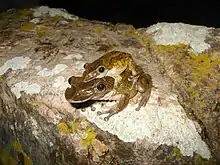Triprion spatulatus
Triprion spatulatus is a species of frog in the family Hylidae. It is endemic to the Pacific lowlands of western Mexico between the Sinaloa and Oaxaca states. It is known by several common names: shovel-headed treefrog, Mexican shovel-headed treefrog, shovel-nosed tree frog, and shovelhead treefrog.[1][2]
| Triprion spatulatus | |
|---|---|
 | |
| A pair in amplexus | |
| Scientific classification | |
| Domain: | Eukaryota |
| Kingdom: | Animalia |
| Phylum: | Chordata |
| Class: | Amphibia |
| Order: | Anura |
| Family: | Hylidae |
| Genus: | Triprion |
| Species: | T. spatulatus |
| Binomial name | |
| Triprion spatulatus Günther, 1882 | |
| Synonyms[2] | |
| |
Taxonomy and systematics
Two subspecies that primarily differ in coloration[3] are sometimes distinguished:[2][3]
- Triprion spatulatus spatulatus Günther, 1882
- Triprion spatulatus reticulatus (Taylor, 1942)
Duellman (1970) allocated specimens from Sinaloa to the nominotypical subspecies and those further south and east to T. s. reticulatus.[3] However, more recent research suggests that populations east of the Isthmus of Tehuantepec represent a distinct but yet undescribed species.[1]
Description
Triprion spatulatus are large frogs, with males reaching 87 mm (3.4 in) and females 101 mm (4.0 in) in snout–vent length. The head has broad labial flanges, giving it a spoon-like shape, as attested in its specific (from Latin spatulus, "spoon") and vernacular names. The eyes are protuberant, moderately large, and anterolaterally oriented. The tympanum is visible but partially obscured by labial and/or postorbital ridges. The fingers bear large discs and some rudimentary webbing. The toes are about two-thirds webbed. The general coloration in the nominotypical subspecies is pale green or yellowish tan with green to yellow flecks. The head is somewhat darker than the back. The flanks have a yellowish cast. The venter is white apart from grayish brown flecks in the voval sac of breedings males. T. s. reticulatus has pale yellowish tan or olive-green coloration with dark brown or black reticulations and spots.[3]
Habitat and conservation
Triprion spatulatus occurs in lowland xeric and thorn-scrub forest and tropical deciduous forest at elevations up to 350 m (1,150 ft) asl. Breeding takes place in the temporary streams and ponds formed by rainfall and is therefore constrained to the rainy season. It is a common species that is not facing significant threats. Fire and changes in rainfall patterns are potential threats. Its range includes the Chamela-Cuixmala Biosphere Reserve.[1]
References
- IUCN SSC Amphibian Specialist Group (2020). "Triprion spatulatus". IUCN Red List of Threatened Species. 2020: e.T56052A53962935. doi:10.2305/IUCN.UK.2020-2.RLTS.T56052A53962935.en. Retrieved 15 November 2021.
- Frost, Darrel R. (2020). "Triprion spatulatus Günther, 1882". Amphibian Species of the World: An Online Reference. Version 6.1. American Museum of Natural History. doi:10.5531/db.vz.0001. Retrieved 23 October 2020.
- Duellman, W. E. (1970). The hylid frogs of Middle America. Monograph of the Museum of Natural History, University of Kansas. Vol. 1. 1–753. doi:10.5962/bhl.title.2835. (Triprion spatulatus: p. 629–637)
